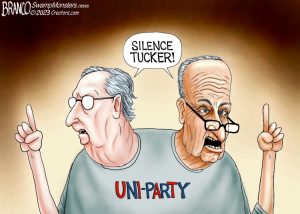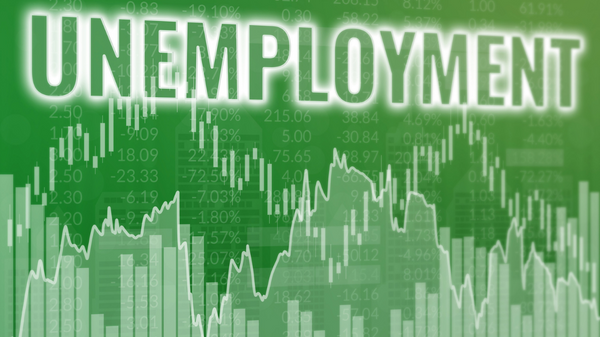Life, Liberty, Property: The Fed’s interest rate hikes aim to slow the economy and raise the unemployment rate.
You need to SUBSCRIBE to Life, Liberty & Property. (It’s free.) Read previous issues.
IN THIS ISSUE:
- Reported Inflation, Real Unemployment
- Don’t Mess with Texas Higher Education
- Rewriting the J6 Story
- Cartoon
Reported Inflation, Real Unemployment

Once again, the Federal Reserve is talking about raising the pace of its ongoing interest rate hikes intended to slow down the U.S. economy. The Wall Street Journal reports:
Chair Jerome Powell said the Federal Reserve would consider raising interest rates by a larger half percentage point this month and was likely to lift rates higher than previously expected this year to cool an economy that has shown surprising strength.
That is what the Fed sees as the problem—the economy is just doing too well:
“The latest economic data have come in stronger than expected, which suggests that the ultimate level of interest rates is likely to be higher than previously anticipated,” Mr. Powell told the Senate Banking Committee. “If the totality of the data were to indicate that faster tightening is warranted, we would be prepared to increase the pace of rate hikes.”
After Powell’s announcement, the Dow fell by 575 points (1.7 percent), the S&P by 1.5 percent, and the Nasdaq by 1.25 percent. I think that the declines would have been even worse if traders hadn’t already priced in this bad Fed news to some extent.
The yield curve, a good predictor of recessions, has inverted further, with two-year Treasury bonds now above 5 percent and 10-year Treasuries down slightly to 3.97 percent.
The chairman’s comments indicate that the Fed will increase interest rates higher than expected and hold them there for longer than originally planned. “By the end of Mr. Powell’s testimony, investors anticipated the fed-funds rate would rise to between 5.5% and 5.75% this year, and the probability of a half-point hike this month rose to around 63%, from 32% before the hearing,” the WSJ reported.
The half-percentage-point increase would double the quarter-point hike the central bank imposed in January, returning to the pace of December, which followed months of even-larger monthly increases of three-quarters of a point.
Friday’s jobs report was good, which means “not good.” Although the unemployment rate rose by two-tenths of a percentage point (“Yay!” says the Fed), employers added almost 90,000 more jobs than economists had expected (“Boo!” says the Fed). The Wall Street Journal reports:
U.S. hiring grew solidly in February as employers added 311,000 jobs. Unemployment rose to 3.6%.
Last month’s job growth, reported by the Labor Department on Friday, aligned with other evidence of resilient economic growth in the face of high inflation and rising interest rates. Payrolls advanced last month on a seasonally adjusted basis at a slower pace than in January, when employers added a robust 504,000 jobs.
Powell on Wednesday told the Senate committee he was keeping an open mind on the matter and would let the data decide what the Fed would do. What that means is that if American businesses don’t quit hiring people and producing more goods and services, the Fed will stop them. Here’s how the WSJ puts it:
The Fed has been trying to curb investment, spending and hiring by raising rates, which makes it more expensive to borrow and can push down the price of assets such as stocks and real estate. The fed-funds rate influences other borrowing costs throughout the economy.
The numbers all indicate the Fed will continue trying to slow the economy. Powell has been intently focused on transitory economic data in adhering to the Fed’s cultural interest in fine-tuning the economy. That contrasts strongly with the central bank’s mandate from Congress, which specifies “the goals of maximum employment, stable prices, and moderate long term interest rates.” Those are clearly not short-term things. As a result, Powell’s rhetoric has been all over the place, notes Joe Wiesenthal of Bloomberg News:
-
-
- Fifth Fed narrative of the year
- January: Recession risk.
- First half of February: Soft landing optimism.
- Second half until Monday: overheating
- Monday-Tuesday: Fed catching up to the overheating, higher got longer
- Wednesday-Thursday: Fed might have to cut its hiking plans short
-
This is all based on the belief that (reported) inflation is caused by excessive economic demand. As a result, the economy needs a stronger dose of high interest rates, Powell told the committee on Tuesday: “We’re looking at a reversal, really, of what we thought we were seeing to some extent,” and “nothing about the data suggests to me that we’ve tightened too much.” The Fed looks at persistent economic growth and low unemployment and sees high inflation. WJS reports:
“The Fed is getting closer to accepting that they aren’t returning inflation to 2% within any reasonable time frame without inducing a hard landing,” said Tim Duy, chief U.S. economist at research firm SGH Macro Advisors.
Certainly, the Fed should base its decisions on the data, but its choices will be beneficial only if (1) the data is both accurate and pertinent and (2) the Fed is correct in what it takes the data to mean.
The key in the current case is the word “reported” as used above. Cato Institute Senior Fellow Alan Reynolds notes inflation has been heading rapidly toward the Fed’s professed goal:
The PCE Inflation rate fell to 2.6 percent in the second half of 2022, down from 7.7 percent in the first half.
To conceal what happened when, that enormous change could be incompetently described as a 5.2 percent inflation rate over 12 months (which is what year‐to‐year changes do).
In fact, Reynolds notes, CPI inflation is now near zero, if you exclude lagged rent data (which we should do):

… or possibly well below zero (as seen in the monthly data):
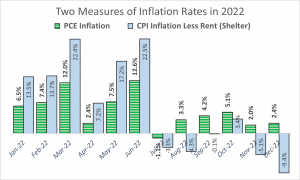
Powell and the Fed want to fight this fictional inflation by killing real jobs. Even worse, the deliberate raising of unemployment invariably leads to further increases in job losses well beyond what the Fed intended (the only exception being in 1980 when the Fed’s abrupt reversal of rate hikes and equally quick reinstitution of vertiginous increases led to the infamous “double-dip” recession).
Wiesenthal notes that the Fed’s efforts to raise unemployment always end up being too successful:
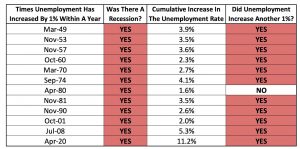
Sen. Liz Warren (D-MA) questioned Powell about this at the Senate committee hearing (h/t Wiesenthal), saying, “So then the question becomes, ‘We’ve got two million people out of work. Can you stop it at two million people?”:
History says the answer is no, Sen. Warren notes.
“Explain that to the two million families that are going to be out of work,” Warren told Powell, echoing comments I made in an article last December.
This is what the Fed has in store the U.S. economy: conquering reported inflation by killing real prosperity.
Sources: The Wall Street Journal; The Wall Street Journal; Cato at Liberty
Subscribe and Get Smarter
Don’t Mess with Texas Higher Education

Florida is not the only state where the government is pushing back against diversity, equity, and inclusion rules implemented by radical political-activist bureaucrats at state-supported institutions. States across the country are now looking at what these people had quietly been up to for the past couple of decades. They dislike what they are seeing, and lawmakers are responding with action on the complaints of parents, students, and influentials.
Accordingly, the Texas A&M University system has announced that it will . . . obey the law, Campus Reform reports:
Amidst the nationwide chorus to eliminate diversity, equity, and inclusion (DEI) in education, the Texas A&M University System (TAMUS) announced on Mar. 2 that it will ban diversity statements from admissions and hiring.
The announcement from TAMUS Chancellor John Sharp follows a Feb. 6 directive from Gov. Greg Abbott. A memo from Abbott’s chief of staff, obtained by The Texas Tribune, told the state’s public colleges and universities to use merit, not DEI, in its considerations.
“We believe serving Texas can be accomplished best by recruiting the brightest and most qualified students, faculty and staff,” Sharp states in the TAMUS announcement.
Sharp also states, “No university or agency in the A&M System will admit any student, nor hire any employee based on any factor other than merit.”
The Texas A&M system comprises 11 universities and eight state agencies. The University of Texas system had earlier announced a “pause” in its DEI programs. Evidently the mad radicals over there are awaiting the election of a governor more appreciative of their efforts. I hope that they will be permanently off-campus and doing something else before that happens.
As you will have discerned from my sarcastic introduction to the Campus Reform quote, it should not surprise us when taxpayer institutions obey the law and accept the will of those who pay for their highly expensive and atrociously inefficient operations. But it does, because that’s the way things have been for a very long time.
Note to America: when radical bureaucrats put their own desires before those of the people who pay their inflated salaries, sic the law on them. If the laws do not reflect the will of the people, insist that they be changed. We have a choice between rule of law and rule of elites. The latter is ruining everything. Change it.
Source: Campus Reform; The Texas Tribune
Rewriting the J6 Story
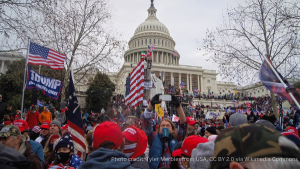
In a truly liberal culture, it would strike one as odd that there is any controversy at all over the release of January 6 video to the public by way of Fox News host Tucker Carlson with the promise of subsequent wider distribution to other journalists. After all, exclusive presentations of government documents have long been considered journalist coups of great value and their presentation seen as a matter of public good and in fact duty.
Not this time. The reason for the difference is quite sinister, in my view. The protestations of Democrats and their media satraps are to be expected, given that they are by nature generally unscrupulous and benefit from anything that makes Republicans look bad. That happens everywhere. Republicans’ condemnation of Carlson for airing the footage and commentary on it this week is much more interesting, as it illustrates the current divide between elites and the populace.
Senate Minority Leader Mitch McConnell typified the reaction, saying, “It was a mistake in my view for Fox News to depict this in a way that is completely at variance with what our chief law enforcement official here at Capitol thinks.”
RedState editor-at-large Kira Davis captures his meaning perfectly:
McConnell may have thought he was simply saying he thinks the Capitol protests were a Very Bad Thing™, but I heard what he (and so many others like him) really thinks. He means he didn’t like THE STORY Tucker Carlson was telling with the new footage. THE STORY already had its tellers. THE STORY had already been framed. THE STORY had already been written. How dare Carlson come in with rewrites? Who approved him to retell THE STORY?
And isn’t that the big takeaway here? McConnell basically admitted that the J6 footage we’ve been seeing for two years is really a story, and not an objective set of facts. If it had been just the facts, there wouldn’t be any controversy about the new footage being released. It never would have been secret in the first place. Like old Twitter threatening to benevolently “add context” to Trump’s tweets for the benefit of their incurious audience, McConnell and company have decided for the rest of us how January 6, 2021 at the U.S. Capitol should be viewed and observed.
It was such a benign but chilling word in this context…depict.
The truth shall set you free—if that is more than a cliche, we’ll know what “story” to believe by how free it makes us. I’m not saying that there weren’t some bad actors at the Capitol that day. I’m not saying that the Tucker Carlson “narrative” is the narrative of that day. What I am saying is that one depiction has ended with a lot of innocent people in jail (unfree, as it were), and has depended on keeping video evidence out of the hands of the general public. The other “narrative” opens up the evidence and the conversation. The other “narrative” would probably ha[ve] resulted in way fewer jail sentences had it been available to the public.
It has long been said, correctly, that knowledge is power. In an unfree society, power is knowledge. What the state says is true, is true. Reality is not even an obstacle.
Source: RedState
Cartoon
